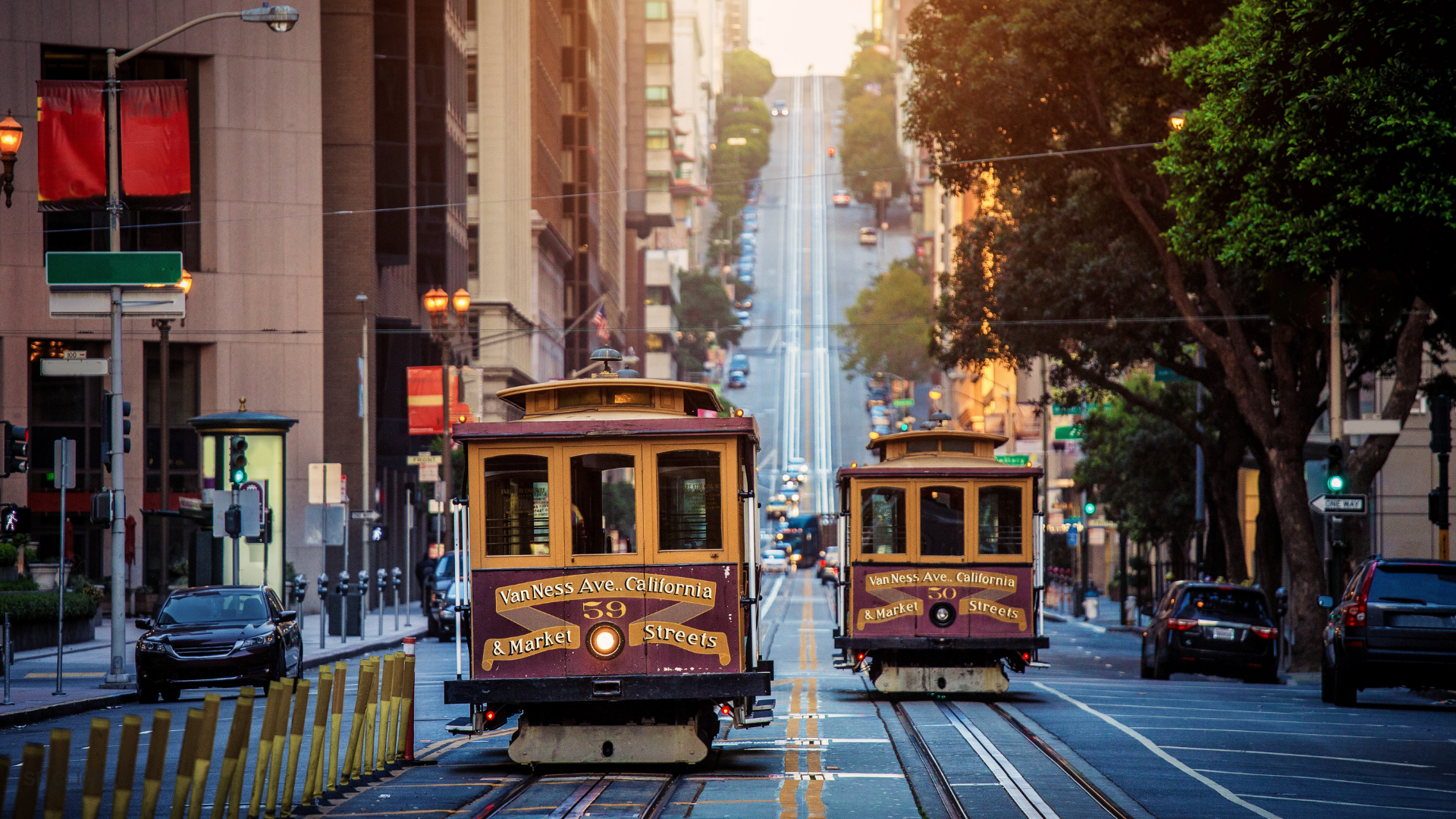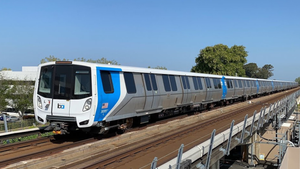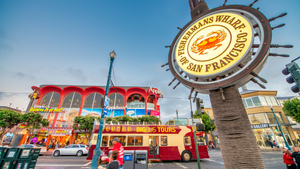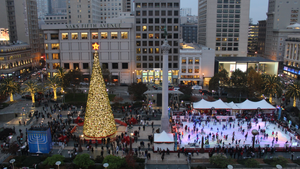
Cable Cars
San Francisco's iconic cable cars, the world's last manually operated cable car system, offer visitors and locals alike a unique way to experience the city's steep hills and stunning vistas. As reported by the San Francisco Municipal Transportation Agency, these National Historic Landmarks have been an integral part of the city's charm and transportation network for nearly 150 years, carrying millions of passengers annually along three distinct routes.
The history of San Francisco's cable cars dates back to 1873 when Andrew Smith Hallidie invented and tested the first cable-driven rail system in the city. Hallidie, a Scots-born mining engineer, was inspired to create this system after witnessing horses struggling to pull a horsecar up a steep, wet cobblestone street. Drawing on his experience with mining conveyance systems and his father's patent for "wire rope" cable, Hallidie developed a steam engine-powered, cable-driven rail system that could safely navigate San Francisco's notoriously hilly terrain.
On August 2, 1873, Hallidie himself operated the first cable car down Clay Street at 4:00 AM, after the designated gripman refused due to the steep grade. This successful test led to the public launch of the Clay Street Hill Railroad on September 1, 1873, marking the beginning of the cable car era in San Francisco.
The success of the Clay Street line sparked a rapid expansion of cable car systems throughout the city. By 1890, eight different companies had established 23 cable car lines, covering 53 miles of track across San Francisco. These lines connected various neighborhoods, from the Ferry Building to the Presidio, Golden Gate Park, the Castro, and the Mission.
However, the dominance of cable cars was relatively short-lived. The introduction of electric streetcars in the 1890s presented a faster and more cost-effective alternative. The devastating 1906 San Francisco Earthquake and Fire dealt a significant blow to the cable car system, destroying power houses, car barns, and 117 cable cars. In the aftermath, many lines were replaced with electric streetcars.
Despite the decline, cable cars persevered on the steepest routes where electric streetcars couldn't operate. By 1912, only eight cable car lines remained, further reduced to five by 1944. In the 1940s and 1950s, the system faced political attempts to shut it down completely. However, public support for the cable cars prevailed, culminating in a 1971 voter mandate that ensured their continued operation and established minimum service levels.
Today, San Francisco operates the world's last manually operated cable car system. The network consists of three lines: two Powell Street lines (Powell-Hyde and Powell-Mason) and the California Street line. These lines use two types of cable cars: 28 single-ended cars on the Powell Street lines and 12 double-ended cars on the California Street line.
In recognition of their historical significance, San Francisco's cable cars were designated as the first moving National Historic Landmark in 1964. This unique system, now over 150 years old, continues to be an integral part of San Francisco's identity and a beloved attraction for millions of visitors each year.
Iconic Landmarks Along the Cable Car Routes
San Francisco's cable car routes offer riders a unique opportunity to experience some of the city's most iconic landmarks and neighborhoods. The three lines - Powell-Hyde, Powell-Mason, and California Street - each traverse distinct areas of the city, providing passengers with diverse views and attractions.
The Powell-Hyde line, often considered the most scenic route, begins at the Powell and Market turnaround near Union Square. As it climbs Nob Hill, passengers can glimpse the famous Fairmont Hotel, an opulent Beaux-Arts building that has been a city landmark since 1907. The line then descends Russian Hill, offering breathtaking views of San Francisco Bay and Alcatraz Island.
One of the most photographed spots along this route is the intersection of Hyde and Lombard Streets. Here, riders can see the famous "crookedest street in the world" - a one-block section of Lombard Street featuring eight hairpin turns. The Powell-Hyde line terminates near Ghirardelli Square, a former chocolate factory turned shopping complex that's now a popular tourist destination.
The Powell-Mason line shares part of its route with Powell-Hyde before branching off towards North Beach. This line passes through Chinatown, one of the oldest and largest Chinatowns outside of Asia. Passengers can observe the neighborhood's vibrant streets, adorned with colorful lanterns and traditional architecture. The line ends near Fisherman's Wharf, allowing easy access to attractions like Pier 39 and the Musée Mécanique.
The California Street line offers a different perspective of the city. Starting in the Financial District, it climbs up to Nob Hill, passing by the imposing Grace Cathedral, an Episcopal church known for its Gothic architecture and stunning stained glass windows. This line also offers views of the Transamerica Pyramid, once the tallest building in San Francisco and an enduring symbol of the city's skyline.
As the California Street cable car continues westward, it passes through the upscale Nob Hill neighborhood, home to luxury hotels like the Mark Hopkins and the Huntington. The line terminates at Van Ness Avenue, providing access to the Polk Street shopping district.
Each cable car route offers a unique slice of San Francisco's diverse neighborhoods and attractions. From historic hotels and crooked streets to vibrant cultural enclaves and stunning bay views, the cable car system serves as both a practical mode of transportation and a moving tour of the city's most iconic landmarks.
The Mechanics Behind Cable Cars
The mechanics behind San Francisco's cable cars are remarkably simple yet ingenious. The system relies on a continuously moving cable running beneath the street in a narrow channel called the "slot". Each cable car is equipped with a device called a "grip," which extends through the slot to grasp and release the moving cable, allowing the car to start, stop, and navigate the city's steep hills. The cable itself is powered by large engines housed in centralized powerhouses, which were originally steam-powered but later converted to use electric motors.
The cars employ a complex braking system to control their speed and stop safely on San Francisco's notoriously steep grades. This system includes wheel brakes, track brakes, and an emergency brake. The gripman, who operates the car, must possess considerable strength, coordination, and skill to smoothly engage and disengage the grip from the cable, especially when crossing intersections or navigating areas where the cable doesn't follow the tracks. This unique mechanical system, largely unchanged since its inception in the 1870s, continues to fascinate both locals and tourists, making the cable cars not just a means of transportation but a living piece of engineering history.
Riding Tips and Times
To make the most of your San Francisco cable car experience, consider these tips on how and when to ride:
The optimal times to ride the cable cars are early morning or later in the evening when lines are shortest. Specifically, around 9:00 am is a good time to take the Powell-Hyde line down to Ghirardelli Square. Cable cars operate daily from 7:00 am to 10:30 pm, running approximately every 10 minutes.
As of 2024, a one-way ride costs $8 for all passengers, with no transfers allowed. Seniors aged 65 and over can ride for $4 before 7 am or after 9 pm. Payment is typically made after boarding, except at the main turnarounds (Powell & Market, Hyde & Beach, and Bay & Taylor) between 8 am and 5 pm, where tickets must be purchased beforehand.For convenience, consider using the MuniMobile app to purchase tickets or passes, especially for families or groups. Alternatively, a Visitor's Passport offering unlimited rides on Muni, Muni Metro, historic streetcars, and cable cars for 1, 3, or 7 consecutive days is available.
The California line typically has the shortest queues.For the best views on Powell lines, sit on the eastern side (right when leaving downtown, left when leaving Fisherman's Wharf).Hold on tightly, especially when standing on the outside ledges.Keep belongings on your lap or at your feet for safety.
Wait for the car to come to a complete stop before exiting.Look carefully before crossing cable car intersections.Bicycles are not permitted on cable cars.Service animals should ride in the interior section when possible.
Remember that cable cars are not equipped with accessible boarding. For a unique experience, try riding up the California Street hill as you pass through Chinatown.
By following these tips, you can enjoy a memorable ride on San Francisco's iconic cable cars while avoiding long waits and ensuring a safe, enjoyable experience.
Famous Stops and Sights
San Francisco's cable car routes offer passengers a unique opportunity to experience some of the city's most iconic landmarks and neighborhoods. Each line provides access to distinct areas, allowing riders to explore famous stops and sights along the way.
The Powell-Hyde line, often considered the most scenic route, begins near Union Square and passes by several notable locations. As it climbs Nob Hill, passengers can see the historic Fairmont Hotel, an opulent Beaux-Arts building that has been a city landmark since 1907. The line then descends Russian Hill, offering breathtaking views of San Francisco Bay and Alcatraz Island.
One of the most photographed spots along the Powell-Hyde route is the intersection of Hyde and Lombard Streets. Here, riders can glimpse the famous "crookedest street in the world" - a one-block section of Lombard Street featuring eight hairpin turns. The Powell-Hyde line terminates near Ghirardelli Square, a former chocolate factory turned shopping complex that's now a popular tourist destination.
The Powell-Mason line shares part of its route with Powell-Hyde before branching off towards North Beach. This line passes through Chinatown, one of the oldest and largest Chinatowns outside of Asia. Passengers can observe the neighborhood's vibrant streets, adorned with colorful lanterns and traditional architecture. The line ends near Fisherman's Wharf, allowing easy access to attractions like Pier 39 and the Musée Mécanique.
The California Street line offers a different perspective of the city. Starting in the Financial District, it climbs up to Nob Hill, passing by the imposing Grace Cathedral, an Episcopal church known for its Gothic architecture and stunning stained glass windows. This line also offers views of the Transamerica Pyramid, once the tallest building in San Francisco and an enduring symbol of the city's skyline.
As the California Street cable car continues westward, it passes through the upscale Nob Hill neighborhood, home to luxury hotels like the Mark Hopkins and the Huntington. The line terminates at Van Ness Avenue, providing access to the Polk Street shopping district.
For those interested in the history and mechanics of the cable cars, a stop at the Cable Car Museum is a must. Located at the corner of Mason and Washington Streets, this free museum allows visitors to see the huge engines and winding wheels that pull the cables. It's not just a museum but also the actual powerhouse of the cable car system, offering a unique behind-the-scenes look at this historic mode of transportation.
Another notable stop is the San Francisco Railway Museum, located near the Ferry Building. This free museum provides information about both the cable cars and the historic F-line trolleys, offering a comprehensive look at the city's rail transit history.
Each cable car route offers a unique slice of San Francisco's diverse neighborhoods and attractions. From historic hotels and crooked streets to vibrant cultural enclaves and stunning bay views, the cable car system serves as both a practical mode of transportation and a moving tour of the city's most famous sights.
Iconic Cable Car Stops
The cable car routes in San Francisco offer access to numerous iconic landmarks and attractions. Here are some of the must-see sights along each line:
Powell-Hyde Line:Union Square: A major shopping district and public plaza at the start of the line.Nob Hill: Home to luxury hotels like the historic Fairmont Hotel, offering panoramic city views.Lombard Street: Known as the "crookedest street in the world" with its eight hairpin turns.Russian Hill: Provides breathtaking views of San Francisco Bay and Alcatraz Island.Ghirardelli Square: A former chocolate factory turned shopping complex at the end of the line.
Powell-Mason Line:Chinatown: One of the oldest and largest Chinatowns outside of Asia, known for its vibrant streets and traditional architecture.North Beach: San Francisco's Little Italy, filled with Italian restaurants and cafes.Fisherman's Wharf: A popular waterfront neighborhood with attractions like Pier 39 and the Musée Mécanique.
California Street Line:Financial District: The city's central business district, home to numerous skyscrapers.Grace Cathedral: An impressive Episcopal church known for its Gothic architecture and stained glass windows.Nob Hill: An upscale neighborhood featuring luxury hotels like the Mark Hopkins and the Huntington.Transamerica Pyramid: Once the tallest building in San Francisco and an enduring symbol of the city's skyline.
Other notable stops:Cable Car Museum: Located at Mason and Washington Streets, this free museum showcases the history and mechanics of the cable car system.San Francisco Railway Museum: Near the Ferry Building, offering information about both cable cars and historic F-line trolleys.
Each route provides a unique perspective of San Francisco's diverse neighborhoods and attractions. The Powell-Hyde line is often considered the most scenic, offering stunning views of the bay and access to famous spots like Lombard Street and Ghirardelli Square. However, all three lines provide opportunities to experience the city's rich history, architecture, and culture while enjoying the iconic cable car ride.
Lombard Street's Crooked History
Lombard Street, particularly its famous one-block section between Hyde and Leavenworth Streets, is one of the most iconic stops along the Powell-Hyde cable car line. This section, known for its eight hairpin turns, has a fascinating history that dates back to the early 20th century.
Originally, Lombard Street was a straight, cobblestone street with a 27% grade, making it too steep for most vehicles and dangerous for pedestrians. In 1922, property owner Carl Henry conceived the idea to reduce the hill's grade and make it more navigable. He proposed transforming the street into a series of switchbacks, similar to those used on mountain roads.
The design was created by engineer William Barclay Parsons, who had previously worked on the New York City subway. The street was reconfigured into eight sharp turns, reducing the grade to a more manageable 16%. The new design was not only functional but also aesthetically pleasing, with flower beds added between the curves to enhance its visual appeal.
Construction was completed in 1923, and Lombard Street quickly became a local attraction. The addition of red brick paving in 1922 further enhanced its charm. Today, the street is lined with beautiful Victorian mansions and meticulously maintained gardens, adding to its picturesque quality.
Interestingly, while Lombard Street is often called the "crookedest street in the world," this title is not entirely accurate. Vermont Street in the Potrero Hill neighborhood of San Francisco is actually more crooked by some measurements. However, Lombard Street's scenic beauty and central location have made it the more famous of the two.
The Powell-Hyde cable car line, which passes by Lombard Street, was not part of the original cable car system. It was created in 1957 as a combination of two former routes, adding to the accessibility and popularity of this unique landmark.
Today, Lombard Street attracts millions of visitors annually. Tourists can either walk down the street's sidewalks or drive down its winding road. For those riding the cable car, the intersection of Hyde and Lombard Streets offers a perfect vantage point to view and photograph this San Francisco icon.
The famous Lombard Street stop on the cable car route thus represents a unique blend of innovative urban planning, scenic beauty, and San Francisco's hilly topography. It stands as a testament to the city's ability to turn geographical challenges into world-renowned attractions.
Related Posts

BART Bay Area Rapid Transit
Bay Area Rapid Transit (BART) is a vital public transportation system connecting San Francisco with communities in the East Bay and South Bay, offering visitors and residents alike an efficient way to navigate the diverse Bay Area landscape.

Fisherman Wharf San Francisco
Fisherman's Wharf, one of San Francisco's most iconic and popular tourist destinations, offers a vibrant mix of family-friendly attractions, fresh seafood restaurants, unique shops, and stunning bay views.

San Francisco's Union Square
Union Square, a bustling 2.6-acre plaza in the heart of downtown San Francisco, is renowned as the city's premier shopping and entertainment district.